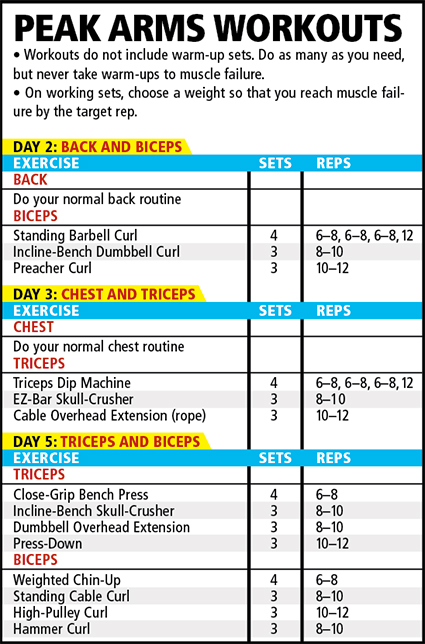6 Weeks To Peaked Arms
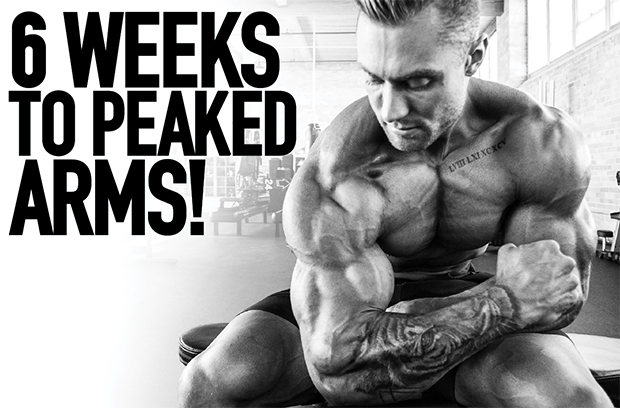
How many articles have you read, whether in a muscle magazine or online, that promise you big arms? Just do these four or five magical exercises and your shirtsleeves will be ripping apart.
Promises, you’ve likely learned, are cheap.
Clearly, particular exercises themselves aren’t magical, though some are certainly better choices than others. But if you’re looking to make some breakthrough gains, you need a larger scale strategy for arm growth. Here’s a simple one that, used as a short-term fix (up to about six weeks), can help to pack on some serious muscle.
Let’s start with your training split. Normally you train arms just once over the course of your split, but instead here you’ll hit the biceps and triceps twice. What’s more, you’ll challenge yourself with more multi-joint exercises—the kinds of movements linked to greater hormone output and muscle growth—that allow you to go heavier and put greater tension on the muscle fibres. The stimulation with sets in the 6 to 8-rep range produces greater mechnical tension than sets of 10 to 12, and mechanical tension is considered the most important factor for muscle hypertrophy.
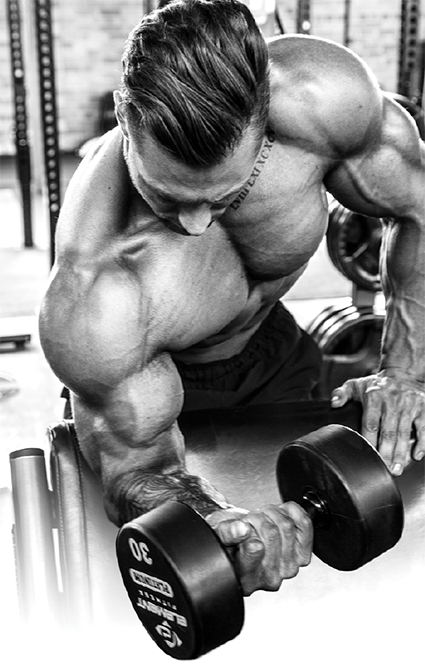
Twice the Arms
Because a smaller muscle group such as the biceps and triceps recovers more quickly than a larger one, you can effectively arrange an intermediate to advanced split to hit it twice. (This isn’t a beginner’s strategy.) However, you have to be especially careful because a muscle grows during recovery, and you normally want to give it at least 48 hours between workouts. If you’re careless with your split, it’s easy to overtrain arms.
Say you do arms on Monday, chest on Tuesday, shoulders on Wednesday, and arms again on Thursday; you’re effectively engaging the triceps on four consecutive days. That will be counterproductive to muscle growth. The same is true when back and biceps are trained on consecutive days. The point is, how you arrange muscle groups is important.

What’s more, during this time your focus should be on arms, so consider scaling back the total volume (number of sets) you may be doing with other body parts, especially with the upper body.
In addition to tinkering with your split, it’s also a good idea to plan these workouts as part of an overall mass-building phase. It’s practically impossible to add arm size when you’re in a caloric deficit. So make sure you’re getting enough total calories and protein to not only recover from your workouts but ensure muscle growth as well.
That also means not missing meals, following a smart supplementation plan, and paying particular attention to your post-workout meal(s). A good rule of thumb: For every 10 pounds of mass you gain, you can expect to add about an inch to your arms.
Construction Zone
Here are some important guidelines for the Peak Arms Workouts below.
1. In the split and workouts presented here, you’ll be doing a pair of biceps and triceps workouts, but you won’t simply be repeating the same workout. That allows you to hit more muscle fibres from different angles to optimize overall development. Also, while one workout is done after training a larger muscle group, the second is done on a day devoted just to arm training, which means your elbow flexors and extensors won’t be prefatigued (see “Splitting Your Arms”).
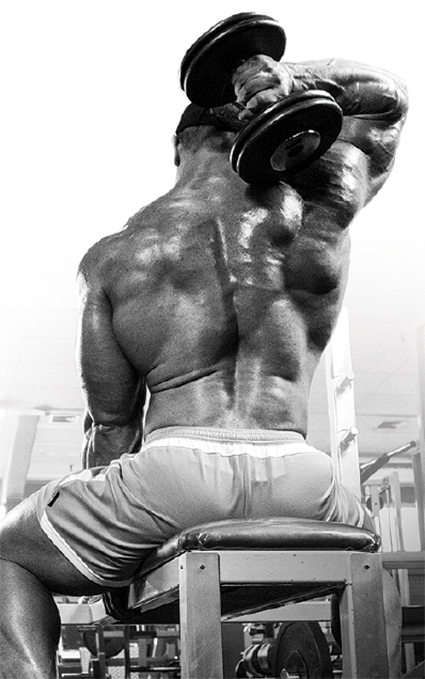
2. The workouts generally start with multi-joint exercises because they allow you to use the heaviest loads. Various kinds of dips (use added weight on the parallel-bar dip, remembering to keep your torso as vertical as possible and limit elbow flare) and close-grip benches are best for triceps, whereas the only real multi-joint biceps exercise is the chin-up (that’s the one with the underhand grip).
3. On the first exercise, after warm-ups, you’re going to use a load that allows you to complete just 6 to 8 reps with good form. That’s a heavier weight than what you use for 10 to 12 reps, so don’t be afraid to push yourself here, getting a spotter if necessary.
4. Don’t be afraid to modify angles. If you’re always doing close-grip benches on a flat bench, try them on a slightly inclined or declined bench. You’ll achieve better overall arm development if you use slightly different angles than what you’re accustomed to. That goes for other exercises that can be done on flat benches, including skull-crushers.
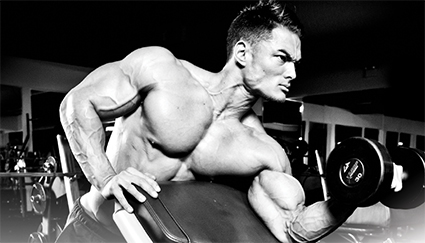
5. Speaking of angles, remember these important tips to selectively emphasize particular biceps or triceps heads.
Biceps long head (peak): Take a slightly closer grip on barbell curls or use incline-bench dumbbell curls, making sure to keep your elbows back as you raise the weights.
Biceps short head: Take a slightly wider grip on barbell curls or use a preacher bench in which your arms are in front of the plane of your body.
Brachialis: Lying underneath the biceps, this muscle is best recruited when using a neutral (hammer) grip.
Triceps long head: Position your arms overhead.
Triceps lateral head: Use multi-joint arm exercises, especially those in which your arms are by your sides or perpendicular to your body.
Triceps medial head: This muscle stabilizes the elbow on most triceps exercises, but you can selectively emphasize it with reverse-grip triceps movements.
6. Add advanced training techniques to goose your workout. Although you don’t want to take every set past muscle failure, pushing yourself a little harder on some (typically your heaviest) sets can create more damage to the muscle fibres. Options include cheat techniques, forced reps, partials, negatives, rest-pause (on multi-joint exercises), and drop sets.
Splitting Your Arms
Here’s a sample training split that repeats every six days, though you can insert another rest day if desired. It’s constructed to avoid working pull muscles (back, biceps) or push muscles (shoulders, chest, triceps) on consecutive days. That allows for at least 48 hours before hitting the arm extensors and flexors again.
Sample Training Split
Day Muscle Groups Trained
- Shoulders, upper traps
- Back, biceps
- Chest, triceps
- Legs
- Triceps, biceps
- Rest
